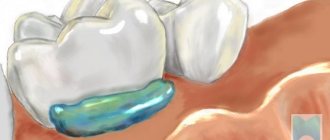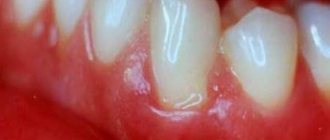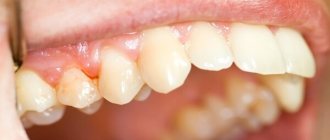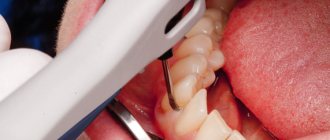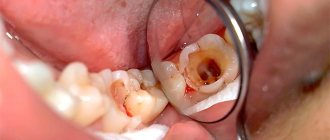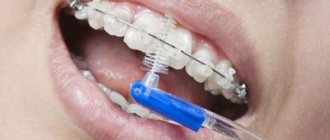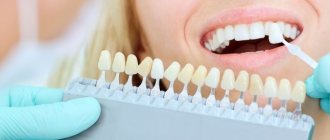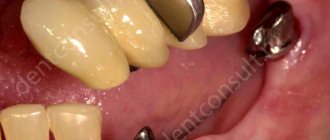Treatment of all types of periodontitis using advanced methods in dentistry, at reasonable prices, with the participation of specialists of the highest category, using innovative equipment and modern materials.
Periodontitis is one of the most serious complications of untreated caries, which affects bone tissue, the root canal, is a source of unbearable pain and requires immediate dental care. Periodontitis, the symptoms of which manifest as sharp pain in the affected tooth, is familiar to most people.
If doctors have the necessary knowledge and professional skills, patients can hope to receive high-quality treatment for periodontitis, the appropriate type and course of the disease.
In the innovative dental clinic "Implantmaster" in Moscow, periodontitis treatment is carried out with the participation of specialists of the highest category, who regularly improve their skills in the best clinics in Europe. We are accustomed to solving complex problems in the shortest possible time and satisfying the needs of even the most demanding patients. Our doctors are constantly improving, mastering new methods of treating periodontitis, using the most advanced materials, using modern equipment for diagnostics (CT of teeth) and treatment of periodontitis (Labomed Magna microscope), setting loyal prices for the services provided.
Next we will talk about methods of treating periodontitis. You will also learn about the main steps that are implemented in the treatment process and will be able to get acquainted with the indications for various treatment methods. You will learn about these and other points below.
Get a consultation
We will answer all your questions before visiting the clinic!
+7
Online registration
Content
hide
1 What is dental periodontitis
2 Indications and contraindications for conservative treatment of periodontitis
3 Treatment methods for dental periodontitis 3.1 Conservative treatment of periodontitis
3.2 Surgical treatment of periodontitis
3.3 Physiotherapy for periodontitis
3.4 Treatment of periodontitis under a microscope
4 Cost of treatment of chronic periodontitis
5 Stages of treatment of chronic periodontitis 5.1 Diagnosis and treatment of tooth canals
5.2 Temporary filling of tooth canals
5.3 Permanent filling of tooth root canals
6 Treatment of periodontitis in the acute stage (acute periodontitis)
7 Emergency dental care in the treatment of periodontitis
8 Prices for periodontitis treatment
9 Errors in the treatment of periodontitis and complications after
10 Is it possible to treat periodontitis at home?
We check the quality
- Sealing should be carried out to the top of the root. In the fluoroscopy image, the canal should be completely filled with white color, which is characteristic of the filling substance.
- Dense obturation of the canal with gutta-percha and sealer. This means that there are no voids in the canal or traces of sealer on its walls.
Although the treatment of periodontitis is a rather complex process, it should not be postponed until later, thereby provoking the risk of complications. Gather the necessary information from available sources and seek help from experienced dentists.
What is dental periodontitis?
Periodontitis is an inflammatory process in the dental root canal and surrounding tissues. In most cases, periodontal damage is infectious. Along with infection, the causes of periodontitis can be acute tooth trauma or its chronic nature, advanced caries, untreated pulpitis, as well as allergies to medications. Any of these reasons, under a combination of circumstances, can cause inflammation of periodontal tissues. This disease usually occurs in acute or chronic form.
- Acute periodontitis . The occurrence of spontaneous localized, pronounced pain is observed; there is redness and swelling of the gingival margin around the causative tooth; the process of inflammation provokes the development of swelling of the soft tissues of the face.
- Chronic periodontitis . The most common periodontal disease, since the number of visits to the doctor for this pathology is low and to a large extent they are detected by chance. This is due to the fact that the pain syndrome is less pronounced than in acute periodontitis; they are often almost asymptomatic. Chronic periodontitis can only be reliably diagnosed using an image of the affected area. On a panoramic photograph of all teeth or a targeted x-ray of a tooth, you can examine the causative tooth and peri-root tissues, but it is better and more accurate to diagnose chronic periodontitis using computed tomography. These diagnostic methods are present in our clinic and are used by our specialists. Each of the various forms of damage to perihilar tissues has its own specifics that must be taken into account during treatment.
Why do you need to remove a tooth?
It is worth noting that partly due to the removal of the diseased tooth, it becomes possible to create an outflow of exudate from the thickness of the jaw, which contributes to better treatment when osteomyelitis appears.
Quite often, there are indications for tooth extraction when a person has chronic periodontitis and an autoimmune disease. The problem is that the inability to quickly rid a person of chronic periodontitis is dangerous due to the development of intoxication of the body and the exacerbation of autoimmune pathology.
As a rule, removal is recommended by therapists and surgeons, thus trying to prevent the possible risk of developing more serious complications. But orthopedists, on the contrary, recommend saving the tooth, since they are confident that for the prosthetic procedure, your own tooth will be the most ideal as a basis.
Indications and contraindications for conservative treatment of periodontitis
There are two main routes that can be followed when treating periodontitis: conservative or surgical. Each direction has its own specific indications and contraindications.
In the modern world of dentistry, based on medical standards, the doctor should preferably use a conservative method for treatment. It is worth noting that the possibility of using a conservative method is determined by the condition of the affected tooth and the patient’s body. Indications for conservative treatment of periodontitis include both acute and chronic periodontitis, the appearance of cysts and granulomas, and tooth mobility.
But in some cases, surgical intervention should be used. The following are considered indications:
- obstruction of the root canals (impossibility of expanding them with modern endodontic instruments);
- the presence of a stump tab or pin that cannot be removed without damaging the roots;
- the presence of a deep bone pocket communicating with the periapical region;
- multiple perihilar cysts or those cysts that have grown into the maxillary sinus;
- perforation in the tooth cavity or root wall;
- large size of the periapical lesion (over 1 cm);
- ineffective conservative treatment methods;
- frequent exacerbations of the process (more than 1 time per month).
Important reasons for deletion
But the final decision on whether to remove or preserve a tooth is made by the doctor in a specific case. In general, indications for tooth extraction may be as follows:
- If the inflammatory process of periodontium appears in milk teeth.
- Incorrect tooth eruption, which injures the mucous membrane in the oral cavity.
- Problems in the eruption of wisdom teeth. Indications for wisdom tooth removal (photo below) include a significant risk of developing inflammation.
- A bruise of the jaw, in which the teeth are located on the fracture line, which, as a result, makes it impossible to correctly compare the fragments.
- Periodontitis grades 3 and 4.
Often, it is the indications for wisdom tooth removal that cause a lot of controversy. But doctors believe that they have no practical significance for humans. Therefore they are removed.
Treatment methods for dental periodontitis
Conservative treatment
Therapeutic:
- X-ray diagnostics;
- providing complete pain relief;
- mechanical treatment of canals using modern technologies for endodontic treatment of periodontitis;
- medicinal (antiseptic) treatment of canals;
- opening of the apical opening of the root canal, for better drainage of purulent periodontitis during treatment under computer control;
- filling the root canal with filling material;
- restoration of the coronal part.
Physiotherapeutic:
- UHF therapy;
- electrophoresis;
- laser therapy;
- medicinal baths and pastes.
Conservative treatment of periodontitis may be accompanied by taking antibacterial drugs as prescribed by a doctor.
Surgery:
- resection of the tip of the tooth root with subsequent filling of the apical part of the canal;
- amputation;
- hemisection (complete removal of one of the roots of the tooth);
- separation;
- replantation;
- removal of a tooth.
Conservative treatment of periodontitis
Drug therapy is used in the treatment of all forms of periodontitis. It is recommended to carry it out for extensive purulent lesions, as well as for tooth mobility. And only in the most extreme and difficult cases, surgical intervention is performed.
Conservative therapy is a gentle method of treating periodontitis in the vicinity of the gums, allowing you to eliminate the inflammatory focus without serious intervention. It is carried out using endodontic techniques for the treatment of periodontitis:
- mechanical treatment of canals with endodontic instruments: passage, expansion, giving the canal a cone shape;
- medicinal treatment of root canals: irrigation with antiseptic solutions, application of calcium hydroxide, other disinfectants and osteotropic agents;
- obturation of root canals.
Conservative treatment of periodontitis is always accompanied by antibiotics.
Surgical treatment of periodontitis
Surgical treatment is resorted to if conservative therapy is impossible or ineffective. Indications for surgical intervention are:
- size of formations – more than 10 mm;
- impossibility of endodontic treatment of periodontitis: obstruction of root canals, orthopedic crowns, stump inlays or pins that cannot be removed without tooth destruction;
- cysts and granulomas in multiple quantities at the roots, growth of formations into the maxillary sinuses;
- perforation of the walls of the roots or the bottom of the cavity.
Surgical methods for treating chronic periodontitis or acute forms are varied and are selected depending on the clinical picture.
1. Resection is the cutting off of the root apex (upper third) along with the surrounding pathological tissues. The operation is performed for periodontitis through an incision on the gum in any teeth, but best of all – 2- or 3-root chewing teeth (molars). In this case, the canals in the teeth must be tightly sealed along the entire length, except for the last third.
2. Amputation is a manipulation similar to resection. It differs in that not a part, but the entire root of the tooth is removed, preserving the crown part. They are carried out on multi-rooted teeth of the upper jaw: more often on molars, less often on premolars. After this operation, it is necessary to perform a retrograde filling. Also, such teeth cannot be used as support for a prosthesis.
3. Hemisection is similar to resection, but it does not cut off the root apex, but completely one of the roots along with the crown. This manipulation cannot be performed on single-rooted teeth.
4. Separation is the most radical tooth-preserving operation for periodontitis. Only one part of the tooth remains, which is weakly stable, difficult to replace with prosthetics and will not last long.
5. Replantation consists of removing a tooth, its endodontic treatment outside the oral cavity, which is best done under a microscope, and returning the unit to its place. Our clinic has all the necessary equipment to carry out this operation - a Labomed Magna dental microscope, a panoramic image and a targeted x-ray of the tooth. Our specialists also have the necessary knowledge and qualifications.
6. Removal is a last resort method in the treatment of periodontitis. It is carried out if other methods have been unsuccessful.
Physiotherapy for periodontitis
Physiotherapeutic procedures are used in addition to the main methods of treatment for apical periodontitis. They help relieve inflammation, normalize tissue trophism, accelerate healing, and also reduce the risk of complications.
When treating periodontal abscess, the following types of physiotherapeutic procedures are performed:
- Electrophoresis . The use of low-intensity current together with the introduction of drugs: antiseptic and anti-inflammatory. As a result, toothaches and inflammation are reduced, and healing is accelerated.
- Coagulation . The effect of high frequency and low voltage electric current on the affected area, which leads to the disappearance of the inflammatory process.
- Ultra-high frequency therapy (UHF) . A high-frequency electromagnetic field affects the source of inflammation. Inflammation is relieved and blood circulation improves. The method is prohibited for use for removing purulent contents - exudate.
- Ultra-high frequency therapy (UHF) . Microwaves are used to relieve pain and relieve spasms.
- Fluctuarization . It is based on the use of low-frequency current of varying amplitude and intensity. When used, pain is reduced, tissue nutrition is improved, purulent formations are resolved, and healing is accelerated.
- Laser therapy . Laser waves help eliminate inflammatory formations, disinfect, and stimulate repair. Mainly used for chronic apical periodontitis during endodontic treatment in teeth with canals of complex anatomical shape.
- Ultrasound therapy (US) . Ultrasonic waves provide micromassage, which has a positive effect on the treatment of chronic periodontitis in the acute stage.
- Ultraphonophoresis . Ultrasound waves are used to administer anti-inflammatory drugs.
- Magnetic therapy (MT) . Exposure to high or low frequency magnetic fields, static or intermittent, with pulses of various shapes, durations and frequencies. With the help of manipulation, inflammation, swelling, pain are reduced and reparative processes in tissues are stimulated.
Treatment of periodontitis under a microscope
For innovative treatment of periodontitis in dentistry at a reasonable price, our Implantmaster clinic in Moscow has all the necessary equipment. Thanks to the multiple magnification of the pulp chamber and canals under the Labomed Magna dental microscope, during treatment our specialists can see the smallest areas of affected tissue, remove them and fully process the tooth canals.
- A clear, enlarged image of the dental cavity allows the dentist to preserve living tissue as much as possible when treating periodontitis under a microscope.
- During dental treatment under a microscope, the patient is in a chair in a lying position, and the doctor sits on the side of the patient’s head, which ensures their comfort.
- In case of periodontitis, dental treatment under a microscope allows the dentist to identify other problems that are just brewing. Such knowledge will help avoid negative consequences.
Also, the advantage of treating periodontitis under a microscope is the preservation of the tooth, with perforation on the roots. Thanks to the use of a microscope, the dentist can perfectly navigate inside the tooth cavity.
Read more about dental treatment under a microscope »
Cost of treatment of chronic periodontitis
For chronic periodontitis, the treatment method with specific stages is the same - the specialist opens the tooth cavity and cleans it of necrotic tissue before opening the pulp chamber; removes purulent contents; fills and, after antibacterial therapy, restores the tooth crown with permanent filling material. All these procedures are carried out by our specialists using a rubber dam to isolate the working field and provide comfort during the treatment of periodontitis at all stages of the technique. The cost of treatment of chronic periodontitis depends on the total number of root canals for the tooth. A larger number of tooth canals exposed to periodontitis increase the cost of treatment.
The number of canals in the roots of teeth varies. The incisors and canines on both jaws, the premolars of the lower jaw have one canal, the premolars of the upper jaw have two. A larger number of canals in the teeth of the lateral segment (3-4). If the tooth has periodontitis, treatment by a doctor will be more difficult; it is necessary to treat and fill each of the canals. Consequently, the greater the number of canals, the higher the cost of treatment for periodontitis. Basically, treatment services for chronic periodontitis range in cost from 6,500 and 11,500 rubles.
It is necessary to take into account that the indicated cost includes only the treatment of the canals and their filling, and the reconstruction of the coronal part, as well as the unfilling of the canals (if the tooth was filled with filling material earlier) are calculated additionally. The final result of chronic periodontitis treatment in price may increase by about 4,000 - 8,500 rubles. You can get complete information about the cost of periodontitis treatment by visiting the doctor’s office at our clinic in Moscow – “Implantmaster”. We offer high quality services at a reasonable cost!
Stages of treatment of chronic periodontitis
How many visits to the dentist’s office will be needed for complex treatment of periodontitis will depend on the stage of inflammation (acute periodontitis, chronic, chronic in the acute stage), as well as the chosen treatment tactics. Periodontitis is often treated in several stages and requires about two or three visits to a dentist; installation of a permanent restoration is not advisable until the inflammatory process is eliminated.
1. Preparatory stage : diagnosis using a panoramic photograph of the teeth, a targeted x-ray of the tooth, as well as control using CT; carrying out anesthesia.
2. Opening the carious cavity or removing the previous filling material to access the pulp chamber, removing the nerve bundle.
3. Expansion of root canal orifices.
4. Treatment of the canals with antiseptic solutions, application of medications, physiotherapy.
5. Installation of a filling using temporary filling material.
6. Removal of temporary filling material , treatment of the canals with antiseptic solutions (this stage is repeated until the inflammatory process subsides; several months of treatment may be required).
7. Control x-ray and placement of a permanent filling.
During visits for periodontitis, antibacterial, anti-inflammatory drugs and rinsing with disinfecting solutions are prescribed for treatment at home.
Diagnostics and treatment of tooth canals
The first place in the treatment of periodontitis is a thorough examination of the patient’s health status, after which the specialist prescribes x-rays. In our clinic, for the convenience of patients, we have CT technology, the ability to take panoramic images of all teeth, as well as targeted radiography of a specific tooth. Thanks to the X-ray image, the diagnosis is made with maximum accuracy. It is also possible to study in detail the number of canals in the roots of teeth, their length and shape. Next, an injection with anesthesia is made into the area of the causative tooth, without which treatment of periodontitis can cause pain and discomfort.
After pain relief occurs, the doctor will perform the following manipulations:
- Removal of all carious tissue from the causative tooth, as well as part of the adjacent unaffected enamel and dentin for better access to the mouths of the root canals;
- In a previously untreated tooth, the doctor will remove the inflamed pulp. In a previously endodontically treated tooth, the tooth canals are unfilled;
- Expansion of the tooth canals using manual and mechanical endodontic instruments, followed by rinsing with an antibacterial solution;
- Placement of medication with enhanced antiseptic effect into the channels;
- Afterwards, a temporary filling is placed;
- The patient is consulted on oral care at home, anti-inflammatory drugs and antiallergic medications are prescribed;
- The next visit to the doctor will take place after completion of the first stage of periodontitis treatment - three days later.
Temporary filling of tooth canals
When you return to a dentist-therapist during the course of treatment for chronic periodontitis, the area for further manipulation is examined. The specialist must clarify whether the patient has complaints of pain, swelling in the gum area of the causative tooth or other discomfort. In the absence of these negative phenomena, temporary filling of the root canals of the tooth is performed.
To do this, first of all, the temporary filling and the antiseptic drug placed in the tooth canals are removed. The canal mouths are carefully treated with an antiseptic and then filled with a special medicinal material that contains calcium hydroxide, a substance that kills pathogenic microorganisms and stimulates the regeneration processes of bone tissue in the area of the apex of the tooth root. Temporary filling of root canals is carried out for a long period - from a month to three. At the end of the visit, the dentist closes the tooth cavity with a temporary filling.
Permanent filling of tooth root canals
During the third visit to the dentist during root canal treatment, a permanent filling is performed. First, the specialist sends the patient for a control x-ray, which determines the effectiveness of periodontitis treatment. If there is a decrease in destroyed bone tissue, permanent canal filling is performed.
The procedure begins with the removal of a temporary filling from the crown of the tooth, then the canals are freed from the previously laid healing material. The doctor rinses the root canals with an antiseptic and then fills them to the root apex with a composite. At the end of the work, the patient is given a final x-ray to control the quality of the filling performed. Gutta-percha pins must be tightly compacted in the canal to the very apex of the root, otherwise there is a high risk of relapse of the disease.
You may have a toothache after periodontitis treatment . Normally, they last 3-5 days and gradually fade away. If the pain does not subside or returns with renewed vigor, retreatment is necessary.
The patient should come to the doctor for installation of a permanent restoration of the crown of the tooth at the next, fourth visit. The filling material in the root canals becomes denser, and the discomfort after intervention in the canals disappears.
Recommendations
Regular oral examinations at the dental office should not be ignored.
A visit to this specialist should be mandatory even if absolutely all teeth are healthy. Do not forget that if the disease is detected in a timely manner, treatment is much simpler and easier than in an advanced stage. When enemy No. 1 of all humanity, caries, appears, treatment must be carried out in a timely manner. Because caries is the main culprit that provokes the onset of periodontitis.
Treatment of pulpitis should be carried out in a timely manner. This rule must also be observed in the case when, after the first visit to the dentist, the pain noticeably subsides. It is important to understand that inflammation must be treated until it is completely eliminated.
Treatment of periodontitis in the acute stage (acute periodontitis)
In the acute stage of periodontitis, two phases are distinguished: intoxication and exudation (appearance of discharge). As the disease develops, the patient first experiences aching and sparse swelling, and then the gums in the area of inflammation pulsate, so treatment cannot be delayed.
Acute periodontitis is divided into serous and purulent. In the second case, pus accumulates at the apex of the tooth root. The main goal in the treatment of acute purulent periodontitis for the doctor is to remove exudate. To achieve this, cleaning the tooth cavity and correct treatment of the canals may be sufficient, but in advanced cases, it may be necessary to resort to dissecting the periosteum to install drainage.
How does periodontitis occur?
Periodontitis is an inflammation of the periodontium - a thin layer of connective tissue that is located between the jaw bone and the tip of the tooth root. The main causes of the pathological process are:
- periodontal infection through dental canals (complication of caries);
- allergic reactions to medications during treatment or prosthetics;
- mechanical injuries: cracks and fractures of the tooth root, inappropriate crown sizes, damage from dental instruments, excessive load on the teeth.
With periodontitis, the connective tissue between the tooth root and the bone bed becomes inflamed.
Periodontitis affects both living teeth and those from which the nerves have been removed. The latter are usually covered with crowns, and this misleads patients: many people believe that a “dead” tooth cannot hurt. However, the periodontium can become inflamed even in the absence of pulp, so the risk zone includes not only those affected by caries, but also teeth hidden under crowns.
Depending on the location of the source of inflammation, periodontitis can be of the following types:
- apical (apical) – develops near the apex of the tooth root (apex);
- lateral - occurs near the lateral surface of the root;
- marginal - adjacent to the gum bordering the root of the tooth.
Advanced periodontitis can lead to tooth loss and other unpleasant consequences.
If periodontitis is left untreated, the infection can spread throughout the body, causing serious illness and even death. The most dangerous forms of this disease are considered to be necrotic and generalized types. In the first case, the pathological process affects bone tissue, and in the second, inflammation develops in several places at once, affecting most of the teeth and adjacent gums. Therefore, at the first symptoms of periodontitis, you should immediately contact a specialist for correct diagnosis and adequate treatment.
Video. The structure of teeth and the development of periodontitis
Emergency dental care in the treatment of periodontitis
While emergency care is provided to the patient during the treatment of periodontitis, it is primarily necessary to open the causative tooth in order to create an outflow of purulent exudate that has accumulated at the apex of the root. If acute periodontitis is accompanied by swelling of the gums, before treatment, an incision is made opposite the apex of the tooth root.
With an open tooth cavity, without a filling, the patient needs to walk around for several days, after which a second visit to the dentist will take place. For the entire period without a filling, when eating and drinking, it is necessary to close the cavity with a cotton swab, and then remove it - this will prevent pieces of food from entering the mouth of the canals, and will also avoid a possible relapse of inflammation.
The stage of providing emergency care as part of the treatment of acute periodontitis is a loyal service at a price. Its approximate cost is in the range from 2000 to 3000 rubles. But you should know that this is not the end of the treatment and it must be continued.
After the tooth cavity is opened during the treatment of acute apical periodontitis, the patient is prescribed a course of antibiotics and oral baths, as well as antihistamines.
Our specialists
- Gogia Tea Zurabovna
Dentist-therapiston Komsomolskaya
- Yarygina Larisa Borisovna
Dentist-therapist
on Kalanchevskaya
- Gracheva Natalia Alexandrovna
Dentist-therapist
on Komsomolskaya
- Bystrikova (Murashkina) Valeria Pavlovna
Dentist-therapist
on Mayakovsky
Prices for periodontitis treatment
Treatment of caries by filling tooth surfaces
- Anesthesia
- Cavity preparation (preparation, medicinal treatment, application of a gasket)
- Filling with light-curing composite
- Grinding and polishing the filling
- X-ray images
Price : from 4,750 ₽ to 8,050 ₽, depends on the number of tooth surfaces affected.
Treatment of caries by placing a ceramic inlay “E-MAX” or “CEREC” or “EMPPRESS”
| from 20,000 to 28,000 ₽ |
Unsealing all tooth canals
| from 4,000 to 8,500 ₽ |
Filling all tooth canals
| from 6,500 to 11,500 ₽ |
| Removing a foreign body from a tooth canal (pins, fragments of instruments, etc.) | 3 000 ₽ |
| Application of medicinal paste into the tooth canals | 2 000 ₽ |
| Sealing tooth fissures | 2 000 ₽ |
| Treatment of caries without drilling the tooth using the “Icon” method | 3 000 ₽ |
| Complete restoration of a tooth with a light-curing composite (Tooth restoration) | 9 500 ₽ |
Prices for periodontitis treatment services vary, depending on:
- severity and form of the inflammatory process;
- the volume of manipulations performed;
- quality of the anesthetics used;
- status and location of the clinic;
- equipment and materials used in treatment.
The standard cost of treatment includes:
- anesthesia;
- if necessary, remove the previous filling material;
- channel processing;
- temporary filling.
More detailed information can be obtained on the clinic’s website or by calling the helpline.
Errors in the treatment of periodontitis and complications after
There are different types of errors and complications in the treatment of periodontitis. If the basic rules of the treatment process are violated (failure to follow the protocol for root canal treatment, ignoring X-rays, insufficient qualifications of the doctor or lack of follow-up therapy), the likelihood of complications is high. In this case, the failure of treatment lies with the doctor. But even compliance with all conditions does not guarantee success. So, if after installing a permanent restoration the previous symptoms persist for 5 days, there is a need for a repeat X-ray of the tooth. Based on the image, re-treatment is prescribed.
Treatment of periodontitis at each stage should be accompanied by a control x-ray to observe the dynamics of the inflammatory process.
Regardless of the reasons that could cause the recurrence of periodontitis, it is necessary to re-treat again with the implementation of all protocols for the technique and safety.
If all measures are not followed, the following complications are possible:
- inflammation of nearby areas of the jaw;
- formation of purulent exudate in the area of the causative tooth;
- the appearance of phlegmon;
- osteomyelitis;
- sepsis (blood poisoning).
Periodontitis, like any other inflammatory process, requires attention from the doctor equally as from the patient. Otherwise, the treatment time for periodontitis will increase significantly.
Is it possible to treat periodontitis at home?
It is impossible to cure periodontitis at home on your own , since the cause of the disease is pathogenic microflora in the dental canals. The only way to remove them from the canals is to treat them with antiseptics and seal the canals, and this can only be done by a specialist. However, by waiting for a visit to the dental clinic, you can relieve symptoms and reduce pain before treatment. Antiseptic agents that do not irritate the mucous membranes can be used for oral baths 4-5 times a day. Doctors also recommend rinsing with a solution of salt and soda in order to relieve swelling and reduce the inflammatory process. Non-steroidal anti-inflammatory drugs are suitable for pain relief. These may help relieve symptoms, but are not treatments.
